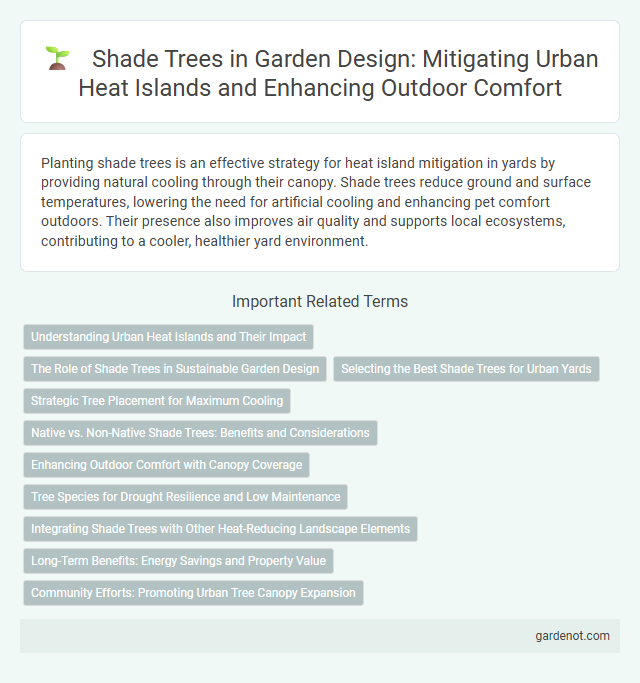Planting shade trees is an effective strategy for heat island mitigation in yards by providing natural cooling through their canopy. Shade trees reduce ground and surface temperatures, lowering the need for artificial cooling and enhancing pet comfort outdoors. Their presence also improves air quality and supports local ecosystems, contributing to a cooler, healthier yard environment.
Understanding Urban Heat Islands and Their Impact
Shade trees play a crucial role in mitigating urban heat islands by providing canopy cover that significantly lowers surface and air temperatures. Their broad, dense foliage intercepts solar radiation, reduces heat absorption by pavements and buildings, and promotes evapotranspiration, which cools the surrounding environment. Studies indicate that strategic planting of shade trees in urban yards can reduce local temperatures by up to 10degF, improving thermal comfort and reducing energy consumption for cooling.
The Role of Shade Trees in Sustainable Garden Design
Shade trees play a crucial role in sustainable garden design by reducing urban heat island effects through natural cooling and providing energy savings by shading buildings. Their extensive canopy moderates local temperatures, improves air quality, and enhances biodiversity by supporting native wildlife. Strategic placement of shade trees in yards optimizes microclimate regulation and contributes to water conservation by reducing soil evaporation.
Selecting the Best Shade Trees for Urban Yards
Selecting the best shade trees for urban yards involves considering species that provide dense canopies, high transpiration rates, and adaptability to local climate conditions to effectively mitigate heat island effects. Trees such as maple, oak, and sycamore are preferred for their broad leaves, longevity, and ability to improve air quality while reducing surface temperatures. Proper placement maximizes shading on buildings and pavement, significantly lowering urban heat and enhancing yard comfort.
Strategic Tree Placement for Maximum Cooling
Strategic tree placement in heat island mitigation yards significantly reduces surface and air temperatures by providing extensive shade and blocking solar radiation. Selecting deciduous shade trees with broad canopies near buildings, parking lots, and walkways maximizes cooling through evapotranspiration and canopy interception. Proper spacing and orientation of trees enhance airflow and minimize heat traps, optimizing urban microclimate regulation.
Native vs. Non-Native Shade Trees: Benefits and Considerations
Native shade trees provide superior heat island mitigation by offering better adaptation to local climate, enhanced support for native wildlife, and lower maintenance requirements compared to non-native species. Non-native shade trees may grow faster or achieve larger canopies but can pose risks such as invasive behavior, reduced biodiversity, and increased water use. Selecting native species like oaks, maples, and elms optimizes environmental benefits and long-term sustainability in urban heat island reduction strategies.
Enhancing Outdoor Comfort with Canopy Coverage
Shade trees play a crucial role in heat island mitigation by providing extensive canopy coverage that significantly reduces ambient temperatures in urban yards. Their broad leaves block solar radiation, lowering surface and air temperatures, which enhances outdoor comfort for residents. Strategically planting shade trees can improve microclimates and reduce reliance on artificial cooling systems.
Tree Species for Drought Resilience and Low Maintenance
Selecting drought-resilient tree species such as Quercus ilex, Prosopis glandulosa, and Ulmus parvifolia is essential for effective heat island mitigation yards, as these species reduce water consumption and require minimal maintenance. These shade trees lower urban temperatures by providing extensive canopy cover, which enhances energy savings and improves outdoor comfort. Their adaptability to arid conditions supports sustainable landscaping practices while promoting long-term ecological benefits.
Integrating Shade Trees with Other Heat-Reducing Landscape Elements
Integrating shade trees with permeable pavements and reflective mulches enhances the cooling effect by reducing surface temperatures and increasing soil moisture retention. Combining shade trees with green roofs or water features creates microclimates that effectively mitigate urban heat island intensity. Strategic placement of shade trees near buildings and sidewalks maximizes shade coverage, lowering ambient temperatures and reducing energy consumption for cooling.
Long-Term Benefits: Energy Savings and Property Value
Shade trees in heat island mitigation yards provide long-term energy savings by reducing cooling costs through natural shading and lowering surrounding temperatures. Mature trees enhance property values by improving aesthetic appeal and creating more comfortable outdoor living spaces. Research shows properties with well-maintained shade trees can see value increases of up to 15%.
Community Efforts: Promoting Urban Tree Canopy Expansion
Community efforts to expand urban tree canopies significantly reduce heat island effects by increasing shade tree planting in residential yards and public spaces. Local organizations collaborate with municipalities to promote native and drought-resistant species that thrive in urban environments, enhancing cooling and air quality. These initiatives foster community engagement and long-term environmental sustainability through education, volunteer planting events, and maintenance programs.
Shade tree Infographic

 gardenot.com
gardenot.com